
Space Quest is a series of six comic science fiction adventure games released between 1986 and 1995. The games follow the adventures of a hapless janitor named Roger Wilco, who campaigns through the galaxy for "truth, justice, and really clean floors".

Indiana Jones and the Last Crusade: The Graphic Adventure is a graphic adventure game, released in 1989 by Lucasfilm Games, coinciding with the release of the film of the same name. It was the third game to use the SCUMM engine.
Mark Seibert is an American musician, composer, and producer best known for his work on various video games from Sierra Entertainment.
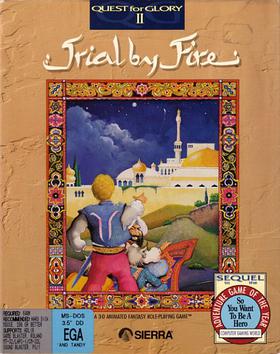
Quest for Glory II: Trial by Fire is the second video game in Sierra On-Line's Quest for Glory series, and the sequel to Hero's Quest: So You Want to Be a Hero.

The Adventures of Willy Beamish is a graphic adventure game developed by Dynamix and published in 1991 by Sierra On-Line. The player takes on the role of nine-year-old Willy Beamish in a game that somewhat parodies the adventure genre. The game pioneered the use of in-game graphics drawn to resemble classic hand-drawn cartoon animation. It was initially released for MS-DOS and the Amiga and was ported to the Sega CD in 1993. CD versions of the game complemented the in-game text with speech, and included a few other cosmetic changes. A sequel was reportedly planned starring Willy Beamish as a late teenager, but the project was canceled.

Freddy Pharkas: Frontier Pharmacist is a comic Old West adventure computer game created by Al Lowe and Josh Mandel and published by Sierra On-Line in 1993. It was dubbed "the Blazing Saddles of computer games" by Computer Gaming World.

King's Quest: Quest for the Crown is an adventure game developed by Sierra On-Line and published originally for the IBM PCjr in 1984 and later for several other systems between 1984 and 1989. The game was originally titled King's Quest; the subtitle was added to the games box art in the 1987 re-release, but did not appear in the game.
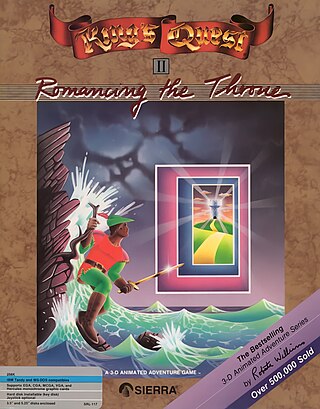
King's Quest II: Romancing the Throne is the second installment in the King's Quest series of graphic adventure games by Sierra On-Line. It was originally released in 1985 for PC DOS/PCjr, and later made available for the Apple II/IIGS, Atari ST, and Amiga. It uses the same AGI game engine as King's Quest I: Quest for the Crown and features King Graham as the player character. The title is a spoof of the 1984 film Romancing the Stone.

King's Quest V: Absence Makes the Heart Go Yonder! is a 1990 graphic adventure game by Sierra On-Line. Originally released in November 1990, it featured a significant improvement in graphics. It was also the first King's Quest installment to replace the typing user interface with a point-and-click user interface. The title is a spoof on the proverb "Absence makes the heart grow fonder".

King's Quest VI: Heir Today, Gone Tomorrow is a point-and-click adventure game, first released in 1992 as the sixth installment in the King's Quest series produced by Sierra On-Line. Written by Roberta Williams and Jane Jensen, King's Quest VI is widely recognized as the high point in the series for its landmark 3D graphic introduction movie and professional voice acting. King's Quest VI was programmed in Sierra's Creative Interpreter and was the last King's Quest game to be released on floppy disk. A CD-ROM version of the game was released in 1993, including more character voices, a slightly different opening movie and more detailed artwork and animation.

Hillsfar is a role-playing video game for MS-DOS compatible operating systems, Amiga, Atari ST, and Commodore 64. It was developed by Westwood Associates and published by Strategic Simulations in 1989. It combines real-time action with randomly generated quests and includes elements of the Advanced Dungeons & Dragons fantasy role-playing game. A port to the Nintendo Entertainment System was released in 1993. Hillsfar received mixed reviews from critics.

Plan 9 from Outer Space is a point and click adventure game adaptation of the film of the same name. It was developed at the Irish office of Gremlin Graphics for the Amiga and Atari ST, and was released in 1992. The game was published by Gremlin in Europe and by Konami in the United States. A DOS version was also developed, though only released in the US and Europe. Two editions of the game were made available at retail; the more common version was packaged with a VHS copy of the film, while a rarer version contained only the game.

Heart of China is a 1991 adventure game developed by Dynamix and published by Sierra On-Line. The game follows the exploits of pilot Jake "Lucky" Masters as he tries to rescue nurse Kate Lomax from a ruthless Chinese warlord.
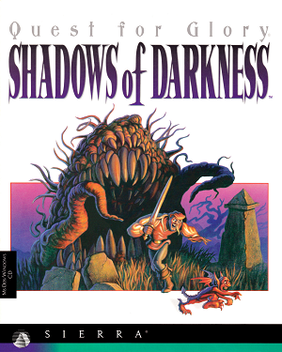
Quest for Glory: Shadows of Darkness is an adventure game/role-playing video game hybrid. It is the fourth installment of the Quest for Glory computer game series by Sierra On-Line. It was the first and only game of the series to drop the numerals from the title.

Space Quest: Chapter I – The Sarien Encounter is a graphic adventure game, created by Scott Murphy and Mark Crowe, and released in October 1986 by Sierra On-Line. It is the first game in the Space Quest series, and sees players assume the role of a lowly janitor on a research ship, who becomes involved in stopping an alien race using a new form of technology for evil purposes.
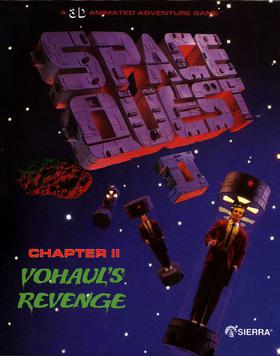
Space Quest II: Chapter II – Vohaul's Revenge is a graphic adventure game released on November 14, 1987 by Sierra On-Line. It is the sequel to Space Quest I: The Sarien Encounter, again using Sierra's AGI game engine, and sees players assume the role of Roger Wilco, a simple janitor who is soon drawn into a new adventure involving thwarting the culprit behind the events of the last game.
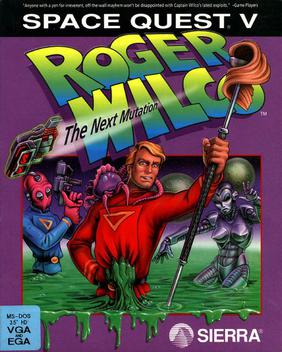
Space Quest V: Roger Wilco – The Next Mutation is a graphic adventure game, created by Dynamix, and released by Sierra On-Line for MS-DOS on February 5, 1993. The game is the fifth entry in the Space Quest series, and the first game to be only designed by Mark Crowe. The story, set within a spoof of the Star Trek franchise, focuses on players taking control of Roger Wilco, who achieves his dreams of becoming a star captain but winds up involved in saving the galaxy from a deadly threat posed by a man-made virus.

Space Quest 6: Roger Wilco in the Spinal Frontier is a point-and-click adventure game developed and published by Sierra On-Line in 1995. It is the sixth and final game in the Space Quest series.

Space Quest III: The Pirates of Pestulon is a 1989 graphic adventure game by Sierra On-Line, and the third game in the Space Quest series. Players assume the role of Roger Wilco, a lowly space janitor, who becomes involved in rescuing a pair of computer programmers from a sinister video game company. The game received positive reviews from critics, and contributed further to the series' commercial success for Sierra. A sequel, Space Quest IV, was released in 1991.

Take a Break! Pinball is a 1993 pinball computer game collection by Dynamix/Sierra On-Line. It contained several individual boards based on various Dynamix or Sierra series such as King's Quest, Space Quest, The Adventures of Willy Beamish, Leisure Suit Larry, and Nova 9: The Return of Gir Draxon. It is the second game in the Take a Break! series of casual Windows games. It was designed for Windows 3.x.



















